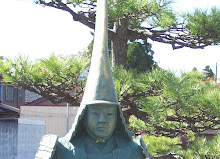 I just received my precious box of dried Japanese persimmon direct from Japan. If you are a lover of dried apricots or cherries, then dried Japanese persimmons will bowl you over!
I just received my precious box of dried Japanese persimmon direct from Japan. If you are a lover of dried apricots or cherries, then dried Japanese persimmons will bowl you over!Persimmons in the Japanese language are called hoshigaki: "hoshi" means "dry" and "kaki" means persimmon. And these sugary Japanese fruit are a traditional gift item sent to friends and family around the New Year.
Many American are unfamiliar with Japanese persimmons, which grow on a tree much like an apple, but have the curious appearance of a tomato.
You eat a fresh Japanese persimmon by cutting off the skin and then slicing it into quarters like an apple, with care taken not to eat the core. Fresh persimmons are best when they are hard and crisp. One variety that is popular is fuyu persimmon.
The dried Japanese persimmon shown to the left is from the west of Japan in Ishikawa prefecture, which is on the Sea of Japan. Driving through the Noto peninsula area of Japan you will notice what appear to be small greenhouses scattered about the countryside; they are actually Japanese persimmon drying "barns," where the fresh round fruit is transformed into a shrunken, narrow slipper of sugar.
Many Japanese houses in the countryside have their own persimmon trees complete with a drying rod attached to the house where they have hung persimmons out to dry; from a distance it looks like a row of beautiful Christmas ornaments.
When the persimmons dry, a wonderful glaze of white crusty sugar crystallizes on the surface of the persimmon; in ancient Japan this natural sugar was scraped off and added to traditional Japanese sweets.
American Japanese culture is linked to this japanese fruit because Japanese-Americans introduced fuyu persimmons and others to California in the last century, and there are now American persimmon orchards throughout the United States.
Eating hoshigaki is a great way to experience an edible part of Japanese culture - enjoy!








1 comment:
Nice story.
Its now persimmon-drying time in Melbourne, but I've never seen it done in this country. Lots of shibui persimmons just live as ornaments on trees, until the possums come.
I will have a go at rescuing and drying them this year.
Ive put my friends stories on how to do it on my blog, but would love any hints.
Post a Comment